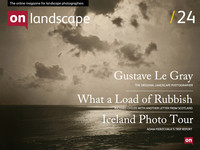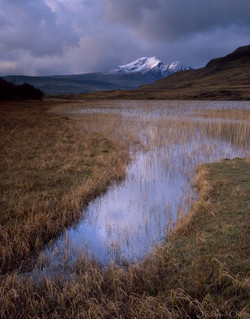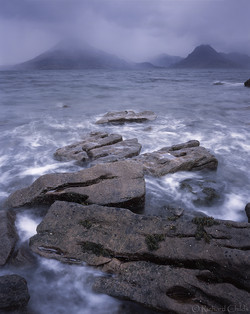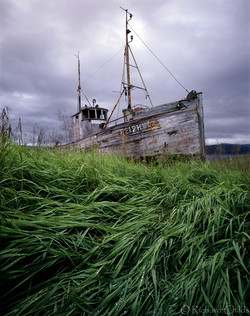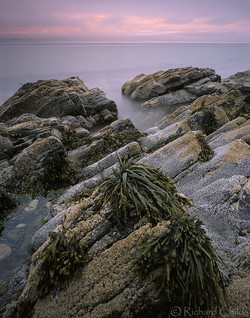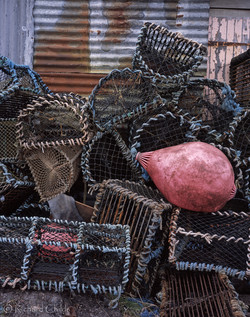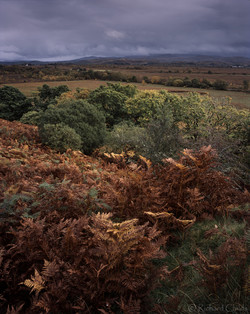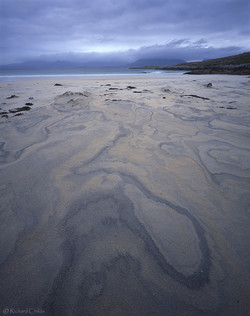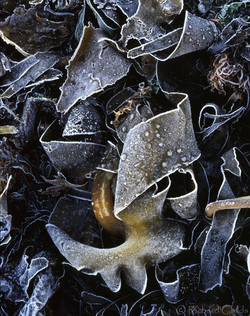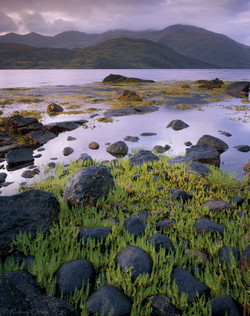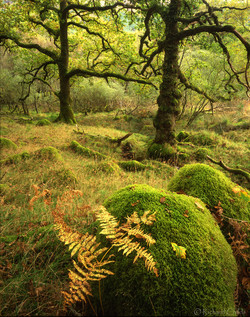Richard Childs questions if there Is such a thing as 'poor light'

Richard Childs
Richard trained as an Orchestral Percussionist in the 1980's but his true love has always been the outdoors and particularly mountain environments. Throwing in his drumsticks to become a full-time photographer in 2004 he continues to work with a large format camera alongside digital equipment and exhibits his work in solo and group exhibitions as well as at his own gallery in the Ironbridge Gorge. Links to Website and Facebook
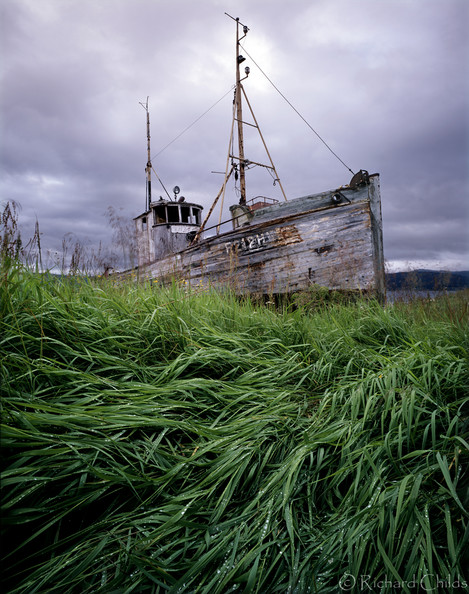 Our minibus pulled quickly into the small lay-by and the doors flew open, my clients spilling out and gathering up their tripods and bags as they went. Before us lay a small Lochan behind which the pyramidal shape of Ben Stack reared, perfectly framed by a notch in the nearer hills. The whole scene was bathed in glorious late September light but the cloud was approaching fast. One client tore off at a great speed through the gate and into the field. Setting up rapidly he fired off a couple of frames before the sun slid behind the cloud and the rest of us arrived. 'I got it' he proclaimed 'and before the light went' he continued. 'But it didn't go' I said 'it just changed'. Other clients were now scouting around the area to find suitable material for their own images and with flatter light, all the autumn colour and texture of the grasses and shrubby bushes was clear to see.
Our minibus pulled quickly into the small lay-by and the doors flew open, my clients spilling out and gathering up their tripods and bags as they went. Before us lay a small Lochan behind which the pyramidal shape of Ben Stack reared, perfectly framed by a notch in the nearer hills. The whole scene was bathed in glorious late September light but the cloud was approaching fast. One client tore off at a great speed through the gate and into the field. Setting up rapidly he fired off a couple of frames before the sun slid behind the cloud and the rest of us arrived. 'I got it' he proclaimed 'and before the light went' he continued. 'But it didn't go' I said 'it just changed'. Other clients were now scouting around the area to find suitable material for their own images and with flatter light, all the autumn colour and texture of the grasses and shrubby bushes was clear to see.
Why are so many photographers convinced that a good image is flooded with sunlight? All light is good for photography as long as it is married to suitable subject matter so why do I hear and read so often of 'poor light' or 'dead light' driving photographers indoors? Mostly I suspect because many photographers have a pre-conceived idea of what makes a good image or more often what they wish to achieve at a chosen location. My facebook news feed is full of comments (usually posted late morning) along the lines of 'rubbish light this morning, hopefully better luck tomorrow' and I can't help but think 'what did you miss while waiting for that golden light and blood red sunrise'. Sometimes images are posted to illustrate how bad it was and all I see is a wealth of missed opportunity.
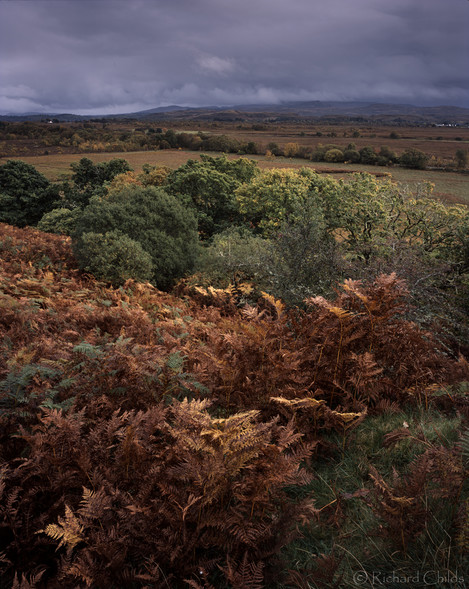 The common perception is that overcast days are great for detail photographs only, the uniform light helping to even out the tone and lift information out of the shadows. The latter part of this sentence is absolutely right of course but if like me you choose to set your wider views against a strong foreground then the same overcast conditions are going to help add rich textural detail. As an estimate, I would say that I now shoot ninety percent of my images under a cloudy sky, not as a friend suggested because Scotland is cloudy 90% of the time but as an artistic choice. I would never say that the light on a blue sky day wasn't worth capturing but choose not to use it very often, especially when shooting a wider view simply because it no longer appeals to me.
The common perception is that overcast days are great for detail photographs only, the uniform light helping to even out the tone and lift information out of the shadows. The latter part of this sentence is absolutely right of course but if like me you choose to set your wider views against a strong foreground then the same overcast conditions are going to help add rich textural detail. As an estimate, I would say that I now shoot ninety percent of my images under a cloudy sky, not as a friend suggested because Scotland is cloudy 90% of the time but as an artistic choice. I would never say that the light on a blue sky day wasn't worth capturing but choose not to use it very often, especially when shooting a wider view simply because it no longer appeals to me.
Cloud does feature heavily on the West Coast of Scotland and has without a doubt played an important part in my development as a photographer in recent years. Besides providing loads of shape and form at the top of my images it also plays a vital roll in lighting my chosen foreground. Winter Herald, Bla Bheinn for example has a near perfect cloudscape that has not only allowed a hint of light to play on the snowy summit but that has also bounced warm light down onto the grasses and reeds of Loch Cille Chriosd from above me. These days I always look to the sky directly overhead just prior to exposing a sheet of film to get a better idea of the colour of the light at my feet. A hole in the cloud above me will cool the foreground enormously no matter how much cloud is visible in the frame and I can choose to filter accordingly should I wish. The reality is that clouds plays an important part throughout my photographs as subject matter, reflectors and diffusers enabling me to fill the frame with detail and rich colour.
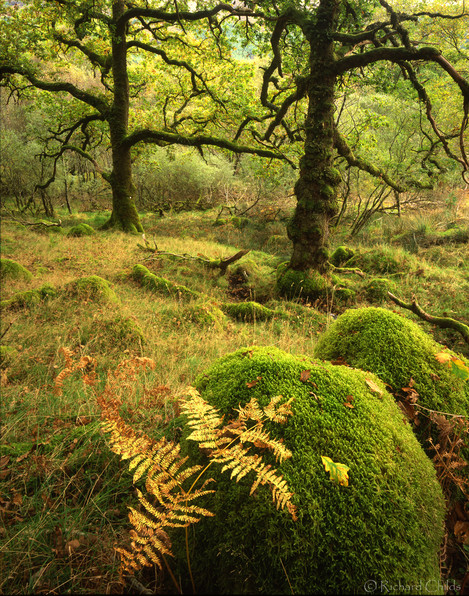 When viewing the image of the Autumn Oaks most people are surprised to learn that it was raining when the film was exposed. All the colour coming from the effect of a bright overcast sky and a canopy of leaves turning to yellow. Had the Sun actually been out this image would not have been possible, certainly on transparency film, cloud playing an important part in controlling the light.
When viewing the image of the Autumn Oaks most people are surprised to learn that it was raining when the film was exposed. All the colour coming from the effect of a bright overcast sky and a canopy of leaves turning to yellow. Had the Sun actually been out this image would not have been possible, certainly on transparency film, cloud playing an important part in controlling the light.
Personally, though it's in the wider landscapes that I find cloud so satisfying. Adding drama, atmosphere, colour and detail that is often lacking in similar scenes shot in so called 'better' conditions. I think these images can provide the viewer with an image of lasting value, one that goes beyond the initial impact of strong colour and contrast to reveal something new on each revisit. One of my clients on my annual Winter Workshop on Skye posted a fantastic image of the Cuillin on Flickr. One that depicts the wonderful island and its mountains in their true Hebridean glory. Quite rightly all the comments placed were positive but I wasn't surprised to find one starting thus; "Always a blow when you get to these locations in poor weather....."!!
To adapt a famous quotation " There's no such thing as poor weather, just a mind closed to its infinite possibilities"
So called poor weather can make photography challenging but the end results certainly provide me with far more satisfaction than those for which I fought less hard. Next time you look out on venture out on a cloudy or wet day, resist that temptation to head home or to the nearest cafe, open your mind and work with the light you are given, the results should astound you, rain is after all invisible in an exposure longer than half a second.
[/s2If]

